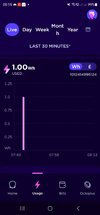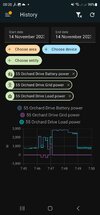This morning I noticed that my Octopus Smart meter showed energy usage from the grid when I expected it not to. The Powerwall had capacity and had already started feeding the house during the grid peak time. But yet at one point there appears to be draw from the Grid. The power draw is well within the capacity of the Powerwall, so why did the Gateway 2 not just let the Powerwall deal with the Load demand, but chose to pull power from the Grid.
You can see in the next graph the battery does kick in later to satisfy demand but it's almost like it's not reacting fast enough to the house's demand.
You can see in the next graph the battery does kick in later to satisfy demand but it's almost like it's not reacting fast enough to the house's demand.




